This article is organized from the keynote speech by Dasha, the founder of Waterdrip Capital, at the Wanwu Island sharing session.
Deteriorating Macroeconomic Environment - A Crisis is Forming a New Order
1.1 Finance is Heading Towards a Chaotic Era
Since Trump returned to the White House, a series of unexpected economic and political measures have caused continuous turmoil in global markets. Among them, one of the most shocking measures is the tariff policy escalation: starting from April 5, 2025, the U.S. will impose a uniform "baseline tariff" of 10% on all imported goods and apply higher "reciprocal tariffs" on 60 countries, including China and Vietnam (with tariffs on China once rising to 125%). In the short term, Trump's tariff stick has caused massive fluctuations in global markets: U.S. Treasuries faced a wave of sell-offs, the 10-year Treasury yield soared to over 4.5%, marking the largest single-week increase in 20 years; U.S. stocks experienced severe volatility, nearly triggering a circuit breaker; the dollar index fell continuously, recording the largest daily drop in several years. Although the U.S. later announced a temporary suspension of new tariffs on some allied countries to gain breathing room, investors remain filled with concerns about future uncertainties, as the global financial system seems to have entered a "chaotic era."
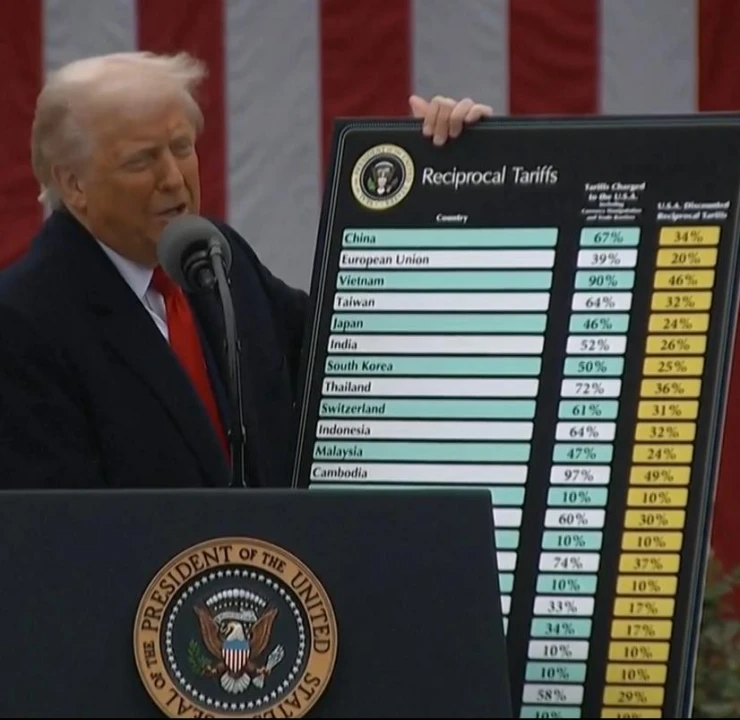
The old international economic system established after World War II, centered around the U.S. (such as the Bretton Woods system and WTO framework), is facing the risk of collapse: the rise of emerging economies has weakened the U.S.'s relative advantage, and the massive debt and fiscal deficits accumulated by the U.S. over the long term are continuously eroding the credibility of the dollar, with the dollar's share in global foreign exchange reserves declining. Especially since China's accession to the WTO, its rapid development has gradually approached or even surpassed the U.S. in many technological fields, triggering deep anxiety among the American elite. Breakthroughs by Chinese companies like Huawei in key technologies such as 5G chip design and communication base stations have raised alarms in the U.S.: the once significant technological gap is rapidly closing, and America's traditional advantages in manufacturing are at risk, while the younger generation of Americans is increasingly engaged in finance and arts, showing less willingness to work in manufacturing. This series of changes indicates that the old order that the U.S. relies on for dominance is loosening.
Against this backdrop, U.S. decision-makers are beginning to brew the construction of a new trade and financial order to maintain their global dominance. The strategic goal of the Trump administration is not only to negotiate better terms in trade talks but also to "start anew"—to re-establish America's central position by formulating a new rule system. This includes two aspects: first, to strike at major competitors, weakening the momentum of countries like China that are rapidly rising by leveraging existing globalization dividends; second, to seek new value anchoring, providing new support for the shaken credibility of the dollar and global trade. Under this thinking, traditional dollar credibility needs to introduce stronger endorsements, and the U.S. has begun to turn its attention to gold and Bitcoin as assets, hoping to rebuild the trust foundation of the global financial system.
It is noteworthy that since Trump took office, the U.S. government's attitude towards the cryptocurrency sector has undergone a significant shift. Shortly after taking office, Trump publicly expressed concern about the development of virtual currencies, reversing his previous critical stance on Bitcoin. Some factions within the Republican Party and certain state governments have gradually embraced Bitcoin in recent years, viewing it as "digital gold" to hedge against dollar risks. It can be said that the U.S. is preemptively laying the groundwork for a potential new financial order, incorporating Bitcoin into its national strategic vision.
1.2 Bitcoin and Gold: The New "Dual Anchors" for the Dollar
As global trade and financial rules face reconstruction, the U.S. is attempting to create a new credit foundation for the dollar through "dual asset anchoring" that includes both traditional gold reserves and emerging Bitcoin reserves. This strategy aims to consolidate the dollar's credibility under the new order through a combination of physical and digital assets.
Gold has long been widely held by central banks as a means of value storage, and the U.S. Treasury's gold reserves (stored in the famous Fort Knox) are an important card for dollar hegemony. Now, Bitcoin is being assigned a similar strategic status—viewed as the "digital gold" of the new era. As of the end of 2024, Bitcoin's total market capitalization is approximately $2 trillion, only about one-tenth of gold's market value (approximately $20 trillion). From a long-term potential perspective, if Bitcoin's market value one day equals that of gold, its price still has several times the growth potential. Due to this growth potential, along with Bitcoin's unique advantages of decentralization, limited issuance (21 million), and high liquidity, the U.S. has begun to seriously consider incorporating it into its national reserve system.
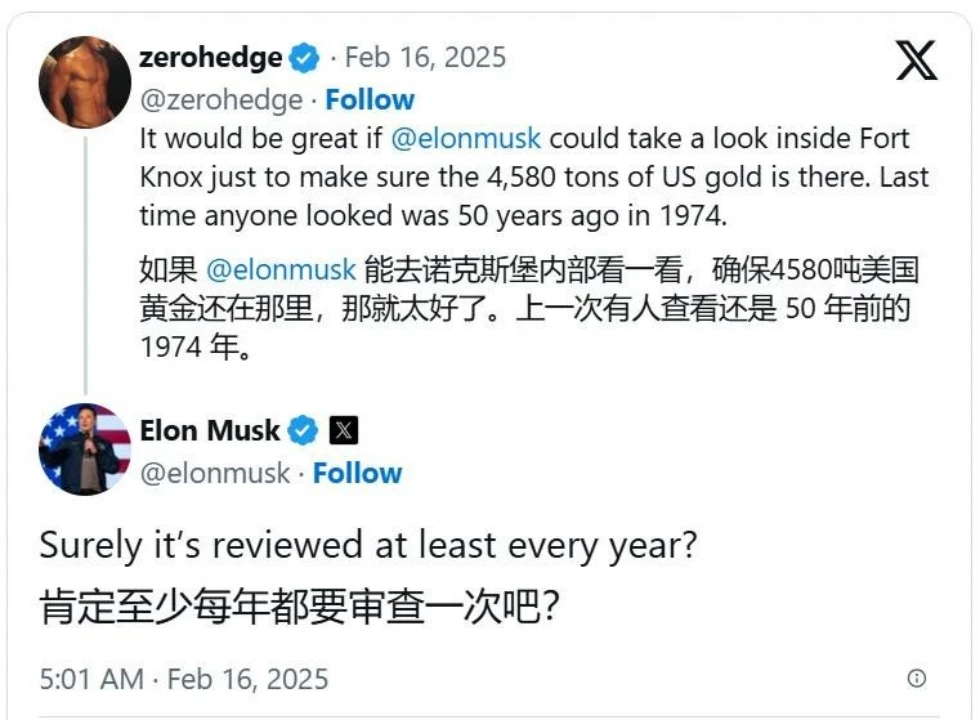
In March 2025, the U.S. government released a series of significant measures in the crypto field: On March 6, President Trump signed an executive order announcing the establishment of a "strategic Bitcoin reserve" and "U.S. digital asset reserve." The next day, the White House held a high-profile crypto summit, inviting industry giants like Coinbase and MicroStrategy, as well as congressional members and officials to participate. Trump publicly expressed support for the development of the crypto industry at the summit, promising to push Congress to quickly pass legislation on stablecoins and digital asset regulatory frameworks to provide a clear legal environment. More notably, Trump stated at the summit: "Establishing a Bitcoin reserve is like establishing a virtual Fort Knox"—meaning that the U.S. intends to view Bitcoin reserves as the gold of the treasury in the digital age. This statement marks Bitcoin's formal entry into the U.S. national strategic level, being assigned a status similar to that of gold.

The above image shows the Bitcoin wallet addresses confiscated by the U.S. government, which are more transparent and decentralized compared to gold reserve vaults.
This series of actions indicates that the U.S. aims to use both Bitcoin and gold as anchoring assets in the new financial system. In practice, the U.S. government already holds a considerable amount of Bitcoin reserves (mainly sourced from law enforcement confiscations) and plans to further increase its holdings. Market rumors suggest a target of accumulating control over approximately 1 million Bitcoins (5% of the total supply), a scale close to the proportion of the U.S. official gold reserves in global gold. Although this goal has not yet been fully realized, the trend is already evident: some U.S. state governments have even taken the lead in approving the purchase of Bitcoin with fiscal funds for reserves; at the federal level, administrative orders and legislative proposals are being used to "legitimize" Bitcoin. If the dollar can be partially anchored to physical gold and digital gold (Bitcoin) in the future, supplemented by blockchain technology to establish a new international clearing system, then the U.S. is likely to seize the initiative in future global financial games, extending the life of the dollar system.
Of course, incorporating Bitcoin also helps the U.S. address its own challenges. For example, the massive national debt burden on the U.S. government is becoming increasingly heavy, triggering a credit crisis. If the U.S. controls enough Bitcoin reserves and pushes its price up in the future, it may cleverly resolve debt risks by selling part of its reserves to fill the debt hole. This idea of "diluting debt with crypto assets" has become a new imagination for U.S. financial strategy. Meanwhile, the U.S. is also intensifying its efforts in digital currency regulation: a recent bill proposed to bring stablecoins with a circulation exceeding $10 billion under Federal Reserve supervision, indicating that the U.S. hopes to control the issuance rights and rule-making authority of crypto dollars (dollar stablecoins) to consolidate the dollar's dominant position in the crypto world. The combination of dollar stablecoins, gold, and Bitcoin outlines the embryonic form of a new dollar order—maintaining the dollar's legal status while being supported by physical and digital assets to enhance risk resistance.
Market Environment Adjustment and "What to Do in the Second Half"
Over the past year, the global crypto market has experienced a dramatic shift from frenzy to calm. The total market capitalization of crypto assets has fallen from a historical peak of approximately $3.71 trillion to around $3.04 trillion (data source: CoinMarketCap, data date: April 23, 2025), as the market enters a deep adjustment and clearing phase. Macroeconomic turmoil (such as rising inflation and interest rates) combined with tightening regulations has caused many projects lacking real value support to disappear in this round of adjustments. However, for entrepreneurs who firmly believe in the long-term value of blockchain, this moment is actually the best time to build a foundation, gather strength, and nurture new opportunities—the bubble of the previous cycle has receded, providing a good opportunity to refine products and emerge.
In this "second half" environment, entrepreneurs should consider: What is suitable to do in the second half? Simple traffic strategies are no longer sustainable; instead, the focus should shift to entrepreneurship logic centered around hardcore value. In the current market environment, the following directions hold new opportunities:
Bitcoin (BTC) Ecosystem: Financial innovations around the Bitcoin network ("BTC Fi"), infrastructure upgrades, and the reconstruction of real assets and payment networks based on BTC.
Other Public Chain Ecosystems: Innovations returning to efficiency and profitability on public chains like Ethereum, breaking away from merely "chasing traffic," and creating sustainable decentralized finance (DeFi) applications driven by products.
Real World Assets (RWA) and Payment Finance (PayFi): Combining on-chain technology with real assets and payment scenarios to develop new models supported by stable cash flows.
Crypto Concept Stocks: Focusing on the rise of "blockchain concept stocks" in traditional capital markets and the new path of Web3 startups towards stock market listing.
Next, we will analyze the above ideas and explore specific entrepreneurial opportunities worth paying attention to during the macro adjustment period.
2.1 Entrepreneurial Opportunities Around BTC: BTC Fi, BTC Infra, BTC RWA & PayFi
Although Bitcoin has long been regarded as "digital gold," its mainnet functionality is relatively simple, but a series of recent technological and application advancements are injecting new vitality into the Bitcoin ecosystem. Around the BTC network, we see three major entrepreneurial opportunities:
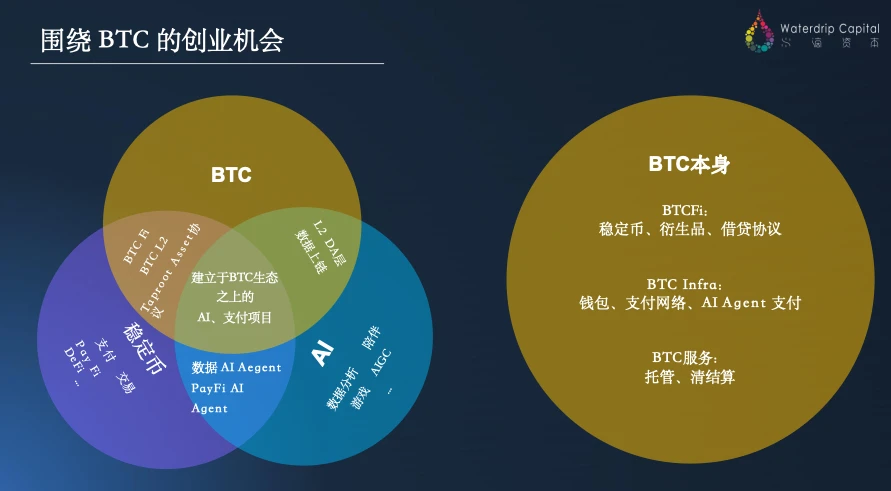
BTC Fi (Bitcoin Finance): Creating new financial assets on the Bitcoin network. Bitcoin is no longer just a static store of value but is evolving into an underlying platform for issuing various financial assets. Recently emerging protocols like BRC-20 and Runes have sparked a wave of token asset issuance on the BTC mainnet; the Taproot Assets protocol (TA protocol) launched by Lightning Labs has made it possible to issue stablecoins, bonds, and other financial assets within the Bitcoin ecosystem. This means that the Bitcoin mainnet is expected to take on more value-bearing functions in the next cycle, upgrading from "digital gold" to a value storage network that supports a rich array of assets. Representative projects such as Bedrock and Solv focus on building decentralized financial services like lending, trading, and derivatives on the Bitcoin network, promoting the leap in BTC financing and asset issuance capabilities.
BTC Infra (Bitcoin Infrastructure): Reshaping the intelligent infrastructure on Bitcoin. To compensate for the shortcomings of BTC's native functions, the industry is attempting to create a smart contract layer for Bitcoin similar to Ethereum. One path is to develop EVM-compatible Bitcoin sidechains or Layer 2 solutions (such as BTC L2 with Ethereum smart contract capabilities) to expand the DApp development space of the BTC network. Another path involves solutions native to the Bitcoin protocol family, such as the RGB protocol and the Lightning Network, which focus more on enhancing privacy, scalability, and payment efficiency, building a lightweight and economical on-chain execution layer for the BTC mainnet. Representative projects like Unisat, Merlin, and B² focus on constructing Bitcoin's Layer 2 and middleware tools, enhancing Bitcoin's development ecosystem and scalability.
BTC-Powered RWA & PayFi: Unlocking Bitcoin's potential in real-world assets and payment fields. RWA based on the Bitcoin network is gradually emerging, such as the tokenization of U.S. Treasury bonds and physical assets, with Bitcoin serving as a settlement layer providing a globally verifiable clearing mechanism, endowing such assets with highly credible value anchoring. At the same time, the "PayFi" model, emerging from payment infrastructures like the Lightning Network, brings Bitcoin back to the payment stage—such as combining AI agents with Bitcoin micropayments, enabling real-time small payments between machines and between people and machines, providing efficient payment solutions for SaaS services, data exchanges, and other scenarios. Representative projects like LNFi focus on enhancing the practical application efficiency and user experience of Bitcoin in RWA and payment scenarios, empowering BTC's payment and circulation.
Overall, the Bitcoin ecosystem is fully awakening from the underlying protocol to the application layer. Whether issuing assets on the BTC mainnet, building a smart contract layer, or using BTC for clearing real assets and instant payments, Bitcoin has the potential to become a fertile ground for innovation and entrepreneurship in the next phase. For entrepreneurs, re-examining the possibilities of the Bitcoin network may uncover undervalued golden opportunities.
2.2 Entrepreneurial Opportunities Around Other Public Chains: Efficiency-Driven and Product-Oriented Entrepreneurship Logic
In addition to Bitcoin, other public chains (such as Ethereum, BSC, Solana, etc.) are also nurturing new entrepreneurial logic and opportunities. After experiencing the DeFi boom and the public chain wars, the industry is beginning to return to rationality, revealing two major trends:
Returning to the "money-making" underlying logic: Whether it is on-chain lending, trading, market-making, or derivatives, as long as it revolves around capital circulation, there will always be ways to validate business models and profit paths. In the past few years, many DeFi projects attracted funds through liquidity mining and other incentive methods, but after enduring the cooling of the market, those models that cannot generate sustained fees and profits are gradually being eliminated. In contrast, on-chain businesses with clear revenue sources (such as transaction fees, lending interest, derivative rates, etc.) have proven their value, similar to traditional finance. This reminds entrepreneurs to re-examine the underlying logic of their projects: do they have a real profit model? In the current environment, businesses that can "make money" have the confidence to weather cycles.
Public chain ecosystems shifting from "traffic competition" to "efficiency competition," with product-oriented entrepreneurship on the rise: Early public chains and protocols were keen to pile on high incentives and package stories to "roll traffic" in order to compete for users and funds, but this purely narrative-driven growth is hard to sustain. Now, capital favors practical projects that enhance efficiency and improve user experience—essentially, entrepreneurship logic that wins through products and technology. Whether it is a new decentralized trading platform, a more efficient market-making mechanism, low-risk lending protocols, or secure and efficient on-chain asset issuance platforms and data service tools, as long as they can solve real needs and run through business models, they are more likely to gain favor. In other words, public chain entrepreneurship is shifting from competing on subsidies and concepts to competing on product strength and efficiency. For entrepreneurs, this means that diligently refining products, optimizing performance, and enhancing user experience will be more important than blindly chasing the elusive "narrative."
In other public chain ecosystems, a new competitive landscape is forming—efficiency-driven becomes the main theme, and product-oriented entrepreneurship is increasingly becoming mainstream. This shift serves as a wake-up call for the entire crypto entrepreneurial circle: only by allowing applications to truly create value and generate revenue can they survive the capital winter and welcome the next spring.
2.3 Sustainable Entrepreneurship Models: Cash Flow-Driven Path Choices
Whether in the Bitcoin ecosystem or on other public chains, creating sustainable cash flow has become a watershed for whether entrepreneurial projects can go far. Traditional capital markets are beginning to evaluate crypto startups by the standards of mature companies, with "cash flow" and "profitability" becoming key assessment criteria. It can be said that traditional investors are redefining the connotation of "crypto companies," opening a window for Web3 entrepreneurs to enter mainstream capital.
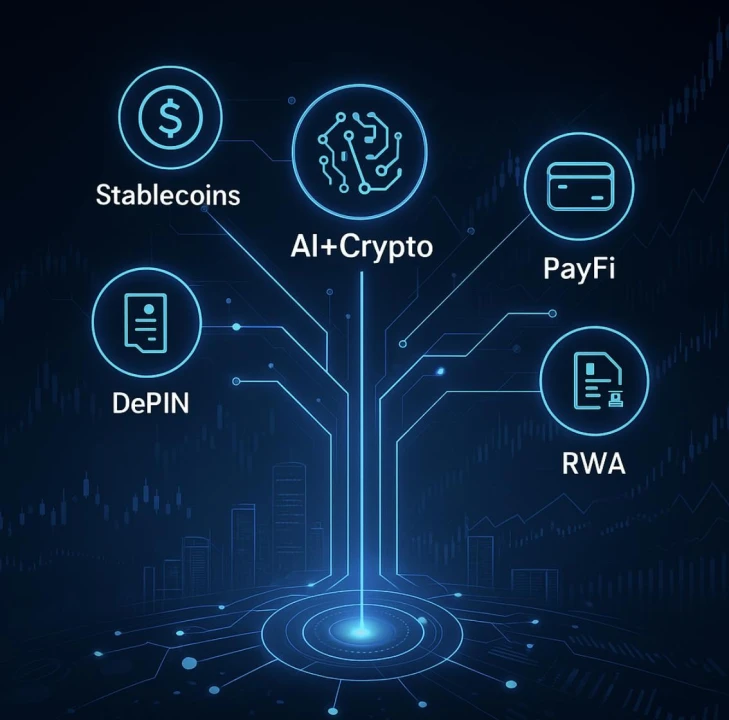
Currently, some crypto projects with real business models are becoming bridges connecting Web3 and traditional capital markets. These projects typically have clear revenue sources, stable cash flow expectations, and good compliance adaptability, thus attracting significant attention from traditional institutions and being seen as the most likely candidates to enter mainstream capital markets through IPOs or mergers and acquisitions.
Among various sub-sectors, DePIN stands out. It constructs a distributed infrastructure network for the physical world by managing real resources like computing, electricity, and bandwidth on-chain, combined with economic incentive mechanisms, naturally possessing a SaaS-style revenue model. Representative projects like PEAQ, Jambo, OORT, and Swan collectively build the key support layer of the DePIN ecosystem, covering machine access, Web3 mobile devices, AI data storage, and computing sharing.
The AI+Crypto sector demonstrates strong integration potential. By combining AI agents, on-chain identities, and micropayment mechanisms, it promotes data interaction and resource scheduling between agents. Projects like Footprint focus on data analysis engines, while DeAgent.ai builds decentralized AI agent protocols to provide services for Web3 smart infrastructure.
The RWA (Real World Assets) direction is rapidly developing, with ongoing tokenization of on-chain U.S. Treasury bonds, corporate bonds, real estate, and other assets, with the market space expected to reach $10 trillion in the future. Representative projects like The PAC provide asset mapping services within a compliance framework, promoting the on-chain circulation of RWA within regulatory boundaries.
PayFi (Payment Finance) has become the most active sector for on-chain transactions. In 2024, stablecoin transaction volume surpassed $15.6 trillion, exceeding Visa for the first time. Projects like Aisa are combining stablecoins with AI wallets to build payment infrastructures that support automation and real-time settlement, serving e-commerce, cross-border, and machine-to-machine payment scenarios.
In summary, these crypto entrepreneurial projects that "can generate cash flow, are easy to value, and have compliance paths" are favored by Wall Street and mainstream capital, being seen as core candidates to enter the mainstream financial system first.
For entrepreneurs, the insight brought by this trend is: Design business models with cash flow in mind. Consider how to generate stable income early in the project, rather than relying solely on token appreciation or subsidy-driven expansion. Only when your project has real-world revenue and profit models can it attract both crypto-native funds and more conservative traditional investors. In a macro environment of turmoil and conservative capital preferences in the "second half," those crypto startups that operate diligently and maintain healthy cash flow are more likely to break through.
Crypto Concept Stocks: Structural Integration into Mainstream Finance
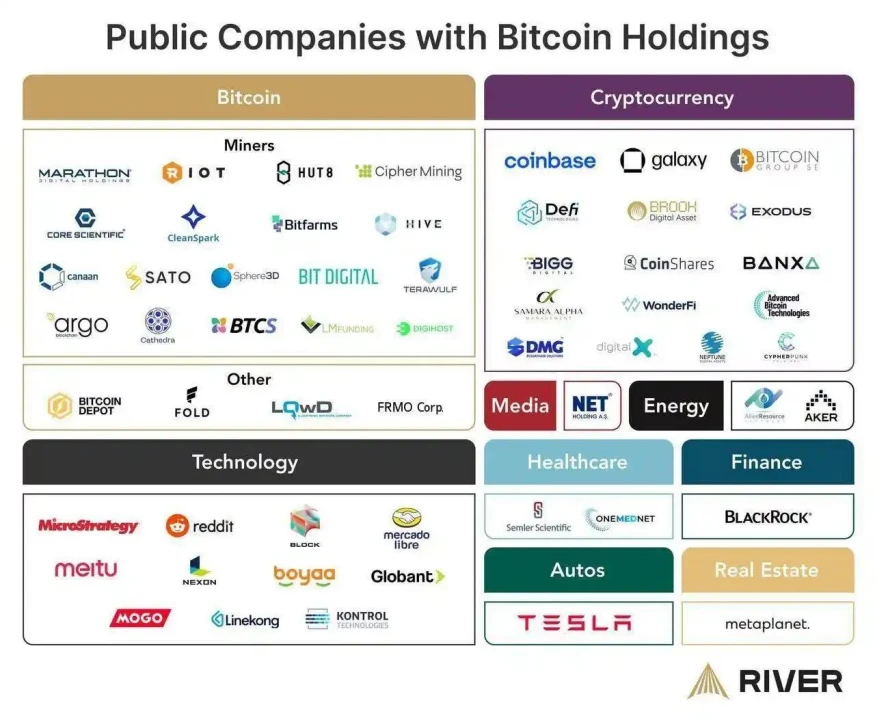
3.1 Classification of Crypto Concept Stocks
The wave of "crypto concept stocks" emerging in traditional capital markets is an important sign of the integration of the crypto industry with mainstream finance. These publicly listed companies participate in the blockchain industry in various ways, providing investors with diversified investment targets. Based on differences in business models and operational focuses, crypto concept stocks can be roughly divided into the following categories:
Asset-Driven (BTC Reserves as Core): The strategy of these companies is to treat cryptocurrencies like Bitcoin as a core part of their balance sheets, amplifying company value by holding a large amount of crypto assets. Typical representatives include MicroStrategy in the U.S., as well as Semler Scientific and Hong Kong-listed Boyaa Interactive. These companies view BTC as a "strategic reserve asset," with an investment logic similar to "crypto version of cash flow + market cap amplifier"—enjoying cash flow from their main business while leveraging the appreciation of their held Bitcoin to enhance market value. Their business models often include a combination of purchasing coins, debt financing, and issuing new shares for coin swaps, carrying a leveraged nature, suitable for investors optimistic about Bitcoin's long-term growth. This suggests that there may be opportunities in areas such as BTC asset management and corporate coin purchasing services.
Mining Concept Stocks (Computing Power Infrastructure Direction): These companies directly participate in cryptocurrency mining and related businesses, with some enterprises expanding from single mining operations to diversified computing power infrastructure. Representative companies include Marathon Digital, CleanSpark, Riot Blockchain, Core Scientific, TeraWulf, and Hut 8. Some mining companies have begun to apply their computing power to artificial intelligence and high-performance computing (HPC) fields, using clean energy to reduce costs and respond to environmental trends—high demand for AI computing power and green energy are becoming their new valuation supports. The development trends of these companies provide directional inspiration for entrepreneurs, such as upgrading Bitcoin mining infrastructure, applying green energy in blockchain computing power, and constructing new data centers that combine Web3 and AI, all of which are worthy exploration tracks.
Infrastructure and Solution Providers: This category includes companies that provide underlying blockchain hardware, cloud services, and technical solutions, with typical representatives being mining machine manufacturer Canaan, mining service company Bitdeer, and cloud mining platform BitFuFu. Their characteristic is to provide "mining tools" and computing power services for blockchain networks, akin to "water sellers" in the crypto industry, serving as core suppliers in the hardware and cloud computing power sectors. The existence of these companies indicates that, at the entrepreneurial level, the middleware layer of the Bitcoin ecosystem (such as solutions to enhance mining efficiency and connect miners with financial services) and "mining as a service" (packaging mining capabilities as cloud services for enterprises or individuals) may be viable business directions.
Exchange Concept Stocks: Companies in this category primarily operate compliant crypto trading platforms or custody services, such as Coinbase (COIN) in the U.S. and digital asset trading platform Bakkt (BKKT). They possess strict regulatory licenses and compliance systems, and their business models are significantly influenced by macro policies and user trading activities. The success of these companies indicates that, under the trend of increasingly refined regulation, compliant financial services will become mainstream. For entrepreneurs, areas such as compliant custody, on-chain trading data analysis, wallet account abstraction, and bridging centralized exchanges with decentralized finance (for example, providing services for CeFi and DeFi interoperability) are worth paying attention to—these are all entrepreneurial opportunities that extend from exchange-type enterprises.
Payment Concept Stocks: These companies have expanded from traditional payment giants to incorporate blockchain payments into their business landscape, with representative enterprises like Block (formerly Square) and PayPal. Their characteristic is to layer Bitcoin or stablecoin strategies on top of their core payment businesses, which have stable cash flows, thus gaining new growth drivers. For example, Block supports Bitcoin transactions in its app, and PayPal has launched cryptocurrency buying, selling, and transfer services. These companies demonstrate the feasibility and value of crypto payments. For entrepreneurial teams, areas such as payment solutions based on stablecoins (like cross-border settlements using USDT), new payment finance (PayFi) products, and AI-integrated smart wallets (like automated investment/payment AI Wallets) are innovative points worth deepening in this field.
The rise of crypto concept stocks is prompting more entrepreneurs to rethink their financing paths. Beyond token financing, the path to stock market capitalization is becoming an important supplement for the new generation of Web3 projects—especially for companies with stable revenue and clear compliance structures, longer-term and more robust capitalization methods are emerging.
Some companies are validating this path through practical cases. For instance, the aforementioned Boyaa Interactive (00434.hk) has successfully achieved a revaluation in the public capital market through a dual-drive strategy of holding coins and business transformation. Meanwhile, Hu Tao Capital (00905.hk) represents another approach—intervening in crypto assets and Web3 projects through an investment holding model, planning to connect traditional securities, unlisted funds, derivatives, and the new blockchain asset system. The company has currently established a partnership with Waterdrip Capital to explore a capital collaboration-based ecological construction path. This "capital collaboration-based" Web3 path does not rely on self-development but utilizes financial capabilities and industrial resources for ecological empowerment, becoming an important part of the current stock market layout. Additionally, Hong Kong Asia Holdings (01723.hk) has also carved out a path transitioning from traditional main operations to digital asset management. Originally focused on construction engineering and prepaid product retail, the company officially purchased Bitcoin as a strategic reserve asset in early 2025 and adjusted its management team to include experienced personnel from the crypto field, gradually establishing a direction for Web3 transformation. Notably, Nano Labs (NA.Nasdaq), as a leading blockchain hardware manufacturer in China, announced in early 2025 that it would allocate part of its dollar reserves to purchase Bitcoin, officially incorporating BTC into its strategic asset allocation system, setting a new paradigm for Chinese blockchain technology companies entering the global capital market.
The diversification of crypto concept stocks shows that blockchain technology is integrating into traditional capital markets through different business models. This not only provides investors with new channels for allocating blockchain tracks but also points entrepreneurs in the right direction: which models are more likely to be recognized by mainstream capital, and which models have been successfully validated in the secondary market. From holding coins for market cap management to expanding mining services and providing foundational services like trading and payments, each model reflects the intersection of blockchain entrepreneurship and traditional business.
3.2 Stock Market Paths for Web3 Entrepreneurship: Coin, Stock, and Dual-Track Progress
In light of the aforementioned trends, especially the successful demonstration of crypto concept stocks, Web3 entrepreneurs are also rethinking their financing and development paths. In the past, crypto projects primarily relied on issuing tokens for financing, but now the path toward stock market capitalization (i.e., traditional equity financing and IPO) is becoming increasingly clear. Overall, there are three optional paths for Web3 entrepreneurship, each with its pros and cons:
"Coin" Path (Crypto Token Financing): Financing and incentivizing the community through token issuance. This path offers high flexibility and quick initiation, suitable for rapidly validating early products and building communities. When market conditions are favorable, rising token prices can also bring considerable funds to the project. However, its downside is high sensitivity to market conditions, with financing amounts and token valuations significantly affected by crypto market fluctuations; at the same time, the uncertainty of regulatory policies in various countries casts a shadow over the pure token issuance model. Teams choosing this path need to address challenges such as token economic design, ongoing market cap management, and compliance risks.
"Stock" Path (Equity Financing and IPO): Following the traditional entrepreneurial route, introducing equity investment, focusing on business implementation and revenue growth, and seeking IPO or acquisition exit once the company matures. In this approach, startups accept investments in equity form, which aligns better with regulatory frameworks and is more easily accepted by conservative institutional investors. Its advantage lies in company valuations being more based on fundamentals (revenue, profit), unaffected by token price fluctuations, leading to more stable long-term development; the downside is that early-stage financing may not be as easy as token issuance, and the speed of user and community expansion may be slower, requiring a longer runway to prove value. This path is suitable for projects with clear business models that can generate cash flow and are prepared for long-term deep cultivation.
"Dual-Track" Path (Token + Equity Parallel): Balancing both crypto and traditional financing methods, leveraging their respective advantages in stages. The usual practice is to issue tokens in the early stages to raise seed community and funds, and once the project matures and has stable income, to conduct equity financing through the establishment of a physical company, even pushing for an IPO. This "dual-track progress" model allows for flexible adjustments at different stages of project development: using tokens to incentivize users and build ecosystems in the early stages, and later using equity to connect to larger capital markets. However, it also requires the team to possess stronger balancing capabilities—managing the token community well while maintaining token value and meeting shareholders' requirements for corporate governance and financial compliance. Currently, some projects in the industry are attempting the dual-track model, such as some DeFi protocols issuing governance tokens while their underlying companies choose to accept VC equity investments and even consider future IPOs. The dual-track model is complex, but if executed properly, it may achieve a 1+1>2 effect.
Regardless of the chosen path, the key is to align with the project's positioning and external environment. Entrepreneurs should comprehensively consider project type, profit model, regulatory environment, and the team's areas of expertise to select the most suitable financing and development route. In the current environment, relying solely on a single path may have limitations; flexibly adjusting strategies based on actual conditions, and even switching or paralleling paths when necessary, can enhance the project's survival rate and success probability.
4. Conclusion
The macro turmoil period presents both challenges and opportunities. The "second half" of the market tests the determination and wisdom of entrepreneurs: only teams rooted in real value and focused on long-termism can weather the winter. Driven by multiple waves such as the BTC ecosystem, the efficiency revolution of new public chains, the on-chain of real assets, cash flow-driven models, and the integration of capital markets, a new generation of blockchain entrepreneurs is facing unprecedented opportunities. Choosing the right track, running through the business model, and effectively utilizing suitable financing paths can transform crises into opportunities, allowing them to stand out in the next cycle and truly achieve the leap from 0 to 1 in blockchain entrepreneurship.
免责声明:本文章仅代表作者个人观点,不代表本平台的立场和观点。本文章仅供信息分享,不构成对任何人的任何投资建议。用户与作者之间的任何争议,与本平台无关。如网页中刊载的文章或图片涉及侵权,请提供相关的权利证明和身份证明发送邮件到support@aicoin.com,本平台相关工作人员将会进行核查。




